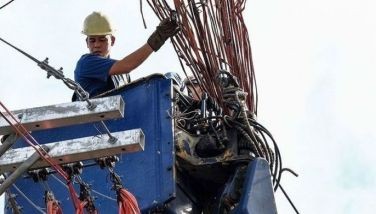USDA asks RP to lift ban on chicken parts from Pennsylvania
February 7, 2002 | 12:00am
The United States Department of Agriculture is appealing to Agriculture Secretary Leonardo Q. Montemayor to immediately lift the ban on the importation of chicken parts from Pennsylvania, which have been found to contain a low pathogenic level of avian influenza (AI) virus.
In a press conference, Dr. Robert Tanaka, director for Asia-Pacific region of the Animal and Plant Health Inspection Service of USDA, and agricultural attaché Mike Woolsey said the USDA has been taking steps to ensure that poultry products from America are safe for humans and the animal population of importing countries like the Philippines.
The Philippines imported in 2000 a total of 7,000 metric tons of chicken parts and another 1.2 million head of day old chicks for breeding, four percent of which came from Pennsylvania, according to Bureau Animal Industry (BAI) Director Dr. Jose Molina.
Tanaka said animal health officials of USDA detected a low pathogenic AI virus in birds in Pennsylvania in December, for which immediate steps had been taken to reduce, if not totally eradicate, the spread of the virus. A low pathogenic level is considered "not a reportable disease according to international standards set by the Office of International Epizootics."
"Therefore, quarantine actions such as a ban on inter-state or international trade, are not necessary," Tanaka said as he added that he met with Dr. Molina and his staff Tuesday to explain what is being done to prevent the spread of the disease and to eradicate it altogether.
But Molina told reporters that Tanaka has not made a firm and conclusive answer as to when the low pathogenic AI will be eradicated. "Unless the USDA can tell us that AI in Pennsylvania has been eradicated, we will not lift the import ban since this can affect our live poultry population as well as pose dangers to humans if the virus mutates from low to high," Molina said.
Molina recalled that in 1983, a similar low pathogenic AI virus developed in Pennsylvania and mutated to high AI, which posed dangers to humans.
Woolsey said the USDA still considers the import ban imposed by the Philippines a technical issue, rather than a trade issue, which is why it is not considering elevating the issue to the appeals body of the World Trade Organization. "But that is an option, if all technical discussions and consultations, prove futile for our chickens," Woolsey said.
Japan, which detected and banned American shipments of chicken parts last December yet, has its own regulations on animal health and AI levels, which, Tanaka said do not jibe with OIE standards. "Japan is a different case and we continue to vigorously oppose this ban," he said.
Molina said the BAI lifted an earlier ban on chicken parts from Connecticut because USDA was able to prove to us that it has completely eradicated the virus. "This is what we are also awaiting in the case of Pennsylvania before we lift the ban on imports," he added.
A press statement circulated by USDA stated that the Philippine government earlier requested extensive information on the situation on Pennsylvania, which it granted. "Nonetheless, on Jan. 30, 2002 it imposed Administrative Order No. 3 and 4, ordering the ban on poultry and chicken products from Pennsylvania and its transshipment," the statement said.
Tanaka said aside from the usual procedures on detection of AI virus stated in the OIE manual on animal health, the USDA went a step further by conducting amino acid sequencing, which is the most modern technique used in detection and treatment of animal viruses.
The USDA said a continued ban on its poultry and poultry products exports would continue to damage the image of US products in terms of safety and hygiene, Woolsey said as he said the conference is aimed at making the public realize that the virus has been dealt with and that there should be no more cause of concern by the Philippine government on health and animal safety.
In a press conference, Dr. Robert Tanaka, director for Asia-Pacific region of the Animal and Plant Health Inspection Service of USDA, and agricultural attaché Mike Woolsey said the USDA has been taking steps to ensure that poultry products from America are safe for humans and the animal population of importing countries like the Philippines.
The Philippines imported in 2000 a total of 7,000 metric tons of chicken parts and another 1.2 million head of day old chicks for breeding, four percent of which came from Pennsylvania, according to Bureau Animal Industry (BAI) Director Dr. Jose Molina.
Tanaka said animal health officials of USDA detected a low pathogenic AI virus in birds in Pennsylvania in December, for which immediate steps had been taken to reduce, if not totally eradicate, the spread of the virus. A low pathogenic level is considered "not a reportable disease according to international standards set by the Office of International Epizootics."
"Therefore, quarantine actions such as a ban on inter-state or international trade, are not necessary," Tanaka said as he added that he met with Dr. Molina and his staff Tuesday to explain what is being done to prevent the spread of the disease and to eradicate it altogether.
But Molina told reporters that Tanaka has not made a firm and conclusive answer as to when the low pathogenic AI will be eradicated. "Unless the USDA can tell us that AI in Pennsylvania has been eradicated, we will not lift the import ban since this can affect our live poultry population as well as pose dangers to humans if the virus mutates from low to high," Molina said.
Molina recalled that in 1983, a similar low pathogenic AI virus developed in Pennsylvania and mutated to high AI, which posed dangers to humans.
Woolsey said the USDA still considers the import ban imposed by the Philippines a technical issue, rather than a trade issue, which is why it is not considering elevating the issue to the appeals body of the World Trade Organization. "But that is an option, if all technical discussions and consultations, prove futile for our chickens," Woolsey said.
Japan, which detected and banned American shipments of chicken parts last December yet, has its own regulations on animal health and AI levels, which, Tanaka said do not jibe with OIE standards. "Japan is a different case and we continue to vigorously oppose this ban," he said.
Molina said the BAI lifted an earlier ban on chicken parts from Connecticut because USDA was able to prove to us that it has completely eradicated the virus. "This is what we are also awaiting in the case of Pennsylvania before we lift the ban on imports," he added.
A press statement circulated by USDA stated that the Philippine government earlier requested extensive information on the situation on Pennsylvania, which it granted. "Nonetheless, on Jan. 30, 2002 it imposed Administrative Order No. 3 and 4, ordering the ban on poultry and chicken products from Pennsylvania and its transshipment," the statement said.
Tanaka said aside from the usual procedures on detection of AI virus stated in the OIE manual on animal health, the USDA went a step further by conducting amino acid sequencing, which is the most modern technique used in detection and treatment of animal viruses.
The USDA said a continued ban on its poultry and poultry products exports would continue to damage the image of US products in terms of safety and hygiene, Woolsey said as he said the conference is aimed at making the public realize that the virus has been dealt with and that there should be no more cause of concern by the Philippine government on health and animal safety.
BrandSpace Articles
<
>
- Latest
- Trending
Trending
Latest
Trending
Latest
Recommended
























